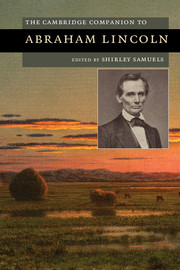Book contents
- Frontmatter
- Introduction
- 1 Rhetorically Lincoln: Abraham Lincoln and Oratorical Culture
- 2 Abraham Lincoln and Poetry
- 3 Seeing Lincoln: Visual Encounters
- 4 Lincoln's Gettysburg Address and Second Inaugural Address
- 5 Lincoln and the Natural Nation
- 6 Abraham Lincoln and the American Indians
- 7 Abraham Lincoln and the Self-Governing Constitution
- 8 Abraham Lincoln and Spiritual Crisis
- 9 America and Britain during the Civil War
- 10 Lincoln in International Memory
- 11 Lincoln's Hemispheric Relations
- 12 Lincoln on Hallowed Ground
- Guide to Further Reading
- Index
9 - America and Britain during the Civil War
Published online by Cambridge University Press: 28 September 2012
- Frontmatter
- Introduction
- 1 Rhetorically Lincoln: Abraham Lincoln and Oratorical Culture
- 2 Abraham Lincoln and Poetry
- 3 Seeing Lincoln: Visual Encounters
- 4 Lincoln's Gettysburg Address and Second Inaugural Address
- 5 Lincoln and the Natural Nation
- 6 Abraham Lincoln and the American Indians
- 7 Abraham Lincoln and the Self-Governing Constitution
- 8 Abraham Lincoln and Spiritual Crisis
- 9 America and Britain during the Civil War
- 10 Lincoln in International Memory
- 11 Lincoln's Hemispheric Relations
- 12 Lincoln on Hallowed Ground
- Guide to Further Reading
- Index
Summary
Of all eminent American public figures over the past 230 years, perhaps none has been as hostile in principle to the idea of transnationalism as Abraham Lincoln. Lincoln's professed goal was to consolidate the United States as “one national family,” a nation predicated on “territorial integrity,” whose Constitution, so he argued in 1864, represented the country's “organic law.” Lincoln began his own career as a policer of national boundaries during the Black Hawk War, Indian skirmishes “in what was then the West.” His lifelong attempt to define and circumscribe the parameters of the nation always impelled him toward a deep suspicion of anything that might undermine the idea of such “organic” unity. Characteristically, Lincoln opposed the Mexican War of the 1840s and expressed no enthusiasm for the annexation of Texas, on the grounds that such expansionist moves might unsettle the U.S. national framework. He himself never set foot outside the country, even when serving as president, and he also resisted moves to reopen the Atlantic slave trade – partly on moral grounds, but also to protect the United States from disruptive foreign influences. In his “Address to the Young Men’s Lyceum” in Springfield, Illinois, delivered in 1838 at an early point in his public career, Lincoln suggested that fears for “some transatlantic military giant to step the ocean, and crush us at a blow” were much less plausible than the likelihood that “danger . . . if it ever reach us . . . must spring up amongst us,” and he stuck to this basic design throughout the rest of his political life.
- Type
- Chapter
- Information
- The Cambridge Companion to Abraham Lincoln , pp. 141 - 154Publisher: Cambridge University PressPrint publication year: 2012



